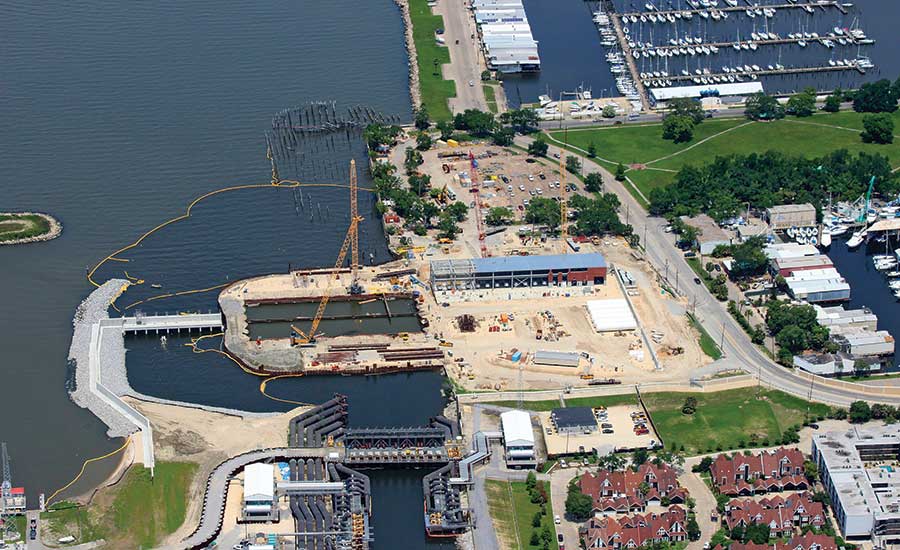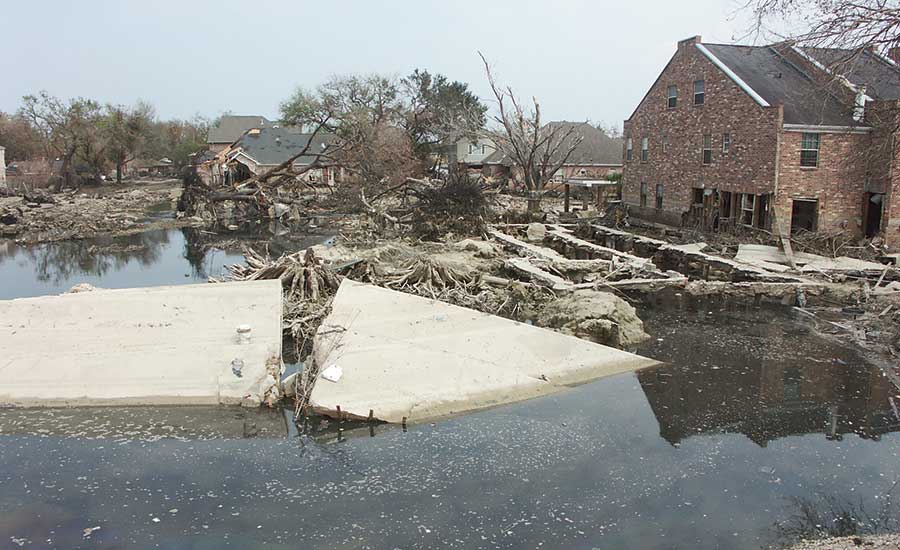Flood Protection and Hurricanes
New Orleans Pushes to Finish Last Big Storm-Surge Project
The final post-Katrina flood protection project nears completion

Getting Ready Work on the permanent pump and storm-surge closure station at the London Ave. canal (pictured above) is set to finish by August 2017, part of the last major project in New Orleans’ $14-billiion flood-defense program. The effort will replace interim pumps installed soon after Katrina hit in 2005. Photos courtesy of PCCP Constructors, A Joint Venture

Getting Ready Work on the permanent pump and storm-surge closure station at the London Ave. canal is set to finish by August 2017, part of the last major project in New Orleans’ $14-billiion flood-defense program. The effort will replace interim pumps (pictured above) installed soon after Katrina hit in 2005. Photos courtesy of PCCP Constructors, A Joint Venture

Catastrophic Failed 17th Street canal floodwall slabs lay among Hurrican Katrina’s debris in the Lakeview section of New Orleans. Photo by Tom Sawyer for ENR

Innovation A trademarked OPEN CELL cofferdam (above) was used for pump-station and closure site construction to allow more efficient work in the clay and tight urban spaces of New Orleans. Photo courtesy of Stantec

Structures Crews (below) will place 70,000 cu yd of structural concrete and 8,000 tons of structural steel to complete the PCCP project. Pump stations will pump a combined 24,300 cu ft per second of water, enough to fill an Olympic pool in 3.64 seconds. Photo courtesy of PCCP Constructors JV

In Action Giant pump is one of 17—each with a 35-year design life—to be installed at the three sites. Photo courtesy of PCCP Constructors JV.

In Action Suction intakes will be installed within pump-station foundations at a depth of up to 50 ft below sea level. Photo courtesy of AP Photo/Eric Gay







On Aug. 29, 2005, Hurricane Katrina pushed water from Lake Pontchartrain into New Orleans’ three major drainage canals, putting pressure on floodwall-topped levees which failed to withstand the load of the water.
The rise of lake water caused the failure in two places of I-walls along the city’s London Avenue Canal and moved by some 35 ft a floodwall on the 17th Street Canal. Through these breaches and others, flood protection failed as water poured into the city—in some places up to 15 ft—and remained for weeks.
In risk areas elsewhere, a federal judge who ruled last year that the U.S. government was responsible for some flooding in the city's Ninth Ward because of its construction and operation of a now-closed navigation canal, on May 4 awarded affected property owners class action status, which could boost their potential for compensation.
After Katrina, the U.S. Army Corps of Engineers became keenly aware that, to protect the city’s interior from future flood surges and damage, it needed to guard these drainage canals, as well as one at Orleans Avenue, with secure pump stations and gates.
While the Corps had temporary gates and pumps in place by the 2006 hurricane season, the long-term solution—construction of a permanent canal protection system—still remains about one year from completion, pushed back by two years of pitched legal battle over project costs, scope and other details among prospective bidders early in the procurement.
The $654-million Permanent Canal Closures and Pumps (PCCP) project now is the last major piece of the $14.6-billion storm risk-reduction system in low-lying New Orleans. The federally funded effort will give the city, which is from 2 ft to 20 ft below sea level, protection from a major storm that has a 1% annual chance of occurring, a so-called 100-year storm.
“The pre-Katrina system was a system in name only,” says Dan Bradley, Corps senior project manager for the PCCP project. “We’ve reduced [risk] by 35% with a true system approach to risk reduction.” Ricky Boyett, district Corps spokesman, adds. “Before, the canals were the first line of defense. Now, they are secondary.”
While not the biggest piece of the overall risk- reduction system—in fact, not even the biggest pump station to be built after Katrina—the PCCP project has been one of the most complex and controversial.
Fine-tuning the desired configuration of the permanent pump stations took months. Next, an epic contracting dispute resulted in the Corps throwing out the original contract, which was awarded to a joint venture of design firm CDM (now CDMSmith) and contractors Brasfield & Gorrie and Yates Construction. In a second round of bidding, the Corps awarded the job to a Kiewit Louisiana Co.-led joint venture that includes Traylor Bros. Inc. and M.R. Pittman Group LLC.
Since the bid was finalized in 2013, work has moved quickly. The design-build project is 98% designed and 78% built. In addition to the complexity and importance of the jobs, the pump stations are being built in the middle of residential neighborhoods, next to a university and along the city’s scenic waterfront. “This type of job was probably a little more difficult,” says John Proskovec, vice president of Kiewit Louisiana. “Other jobs don’t have this type of risk involved. There’s a lot more scrutiny.”
By April 2017, the permanent system at Orleans Avenue should be ready for testing and placed into service, with London Avenue following in August and the 17th Street canal in September, according to the Corps.
Battle-Tested Flood Protection
Those structures will replace the $400-million interim closure and pump stations, the first post-Katrina project the Corps undertook after dewatering the city, which was 80% flooded—in some places, up to 15 ft. By 2007, the three canals were outfitted with a combination of 73 hydraulic, direct-drive and bridge pumps that gave New Orleans a certified higher level of storm protection.
From the beginning, the Corps acknowledged the temporary fix was meant to last only five to seven years.
The interim structures were battle-tested during hurricanes Ike and Gustav in 2008 and Isaac in 2012, but they began rusting and causing problems within a few years. Some pumps were pulled out of the water and refitted with stainless-steel parts. At least one of the pumps is out of service and undergoing maintenance at all times, says Boyett. Annual operation and maintenance for the interim structures is a $5-million expense.
The permanent pump stations, by contrast, are meant to last 100 years. The 17 Patterson pumps—a combination of models that pump from 900 to 1,800 cu ft of water per second—have a design life of 35 years and were engineered and ordered specifically for the city’s pump stations as one of the first bid packages released for the job in 2013. Baldor Electric’s vertical-gear motors will drive the pumps.
The PCCP projects will have floodgates to protect the canals from a 16-ft storm surge from Lake Pontchartrain and the cumulative ability to pump 24,300 cu ft of water per second from the city’s interior—enough water to fill an Olympic-sized swimming pool in 3.63 seconds.
Unless there is a storm, the gates will remain open, and water will flow out of the canals on its own. But if there is a surge in the lake, the gates will be dropped and the pumps will begin sending water to the lake.
Each permanent pump system will have its own diesel generators, housed in a building that includes a bypass gate and enough fuel to keep the motors and pumps operating continuously for five days. Cranes permanently installed in the building will enable maintenance. All facilities will be tied into Lake Pontchartrain’s floodwalls. Project specifications indicate that the components of all three pump stations are meant to be interchangeable, boosting efficiency in operations and maintenance.
The PCCP project’s design-build process has allowed its designer of record, Canada-based Stantec, to add multiple refinements. The last major upgrade came last year, when the New Orleans Sewerage and Water Board requested that the pump motors have variable frequency drives and the necessary electrical switches to enable the agency, as pump-station operator, to turn pump motors on or off as many times as necessary during a storm.
Earlier designs called for automatic transformer starters, which would have allowed the motors to be turned on only three times in two hours. The pump-station changes required new equipment and design modifications, which hiked the overall cost and delayed completion by seven months.
Pump-station design features include foundations—where the suction intakes will be—that are 40 ft deep at Orleans Avenue and 50 ft deep at17th Street and London Avenue. The deep pump stations give the city and state an option, at some point, to remove interior pump stations and allow water to flow by gravity to the PCCP pump stations. In this scenario, the canals would be permanently closed to the lake, and larger pumps would operate constantly to send the drainage water to the lake.
The Corps considered that option for the PCCP but ruled it out after initial estimates said the configuration would cost $3.5 billion.
Instead, the Corps had Stantec design the pump stations so they could be used if the gravity-fed canals were developed in the future. “Everything had to be designed for that,” Bradley says. In addition to the lower intakes, the superstructures had to be designed to house larger pumps and cranes.
The Right Cofferdam
From the beginning of the bidding process, the joint venture knew that using a regular cofferdam would not work in the tight urban jobsite and soil conditions in New Orleans. “Coming up with the right cofferdam was key in, No. 1, getting the job, and No. 2, getting it done,” says Proskovec.
The team turned to PND Engineers Inc., an Alaska-based firm Kiewit had worked with previously, to use its so-called OPEN CELL cofferdam, a patented design that is trademarked in the U.S., Canada and the European Union. But the job was still challenging, as it was the largest such OPEN CELL application that PND had ever designed.
“There’s nothing else to compare it to,” says Rian Johnson, a PND principal engineer. The cofferdam’s OPEN CELL design requires sheetpile to be driven into the ground and anchored from the outside of the wall, with a tail wall about every 28 ft. The soil supports the tail wall, as the clay “sticks to the tail wall like a Post-it note,” says Johnson. Since the wall is braced from the outside, the interior of the cofferdam is clear of any supports, allowing work to occur without stopping to move them.
At the 17th Street canal site, the 40- to 50-ft-deep cofferdams were as large as a football field and strong enough to support a 300-ton crane within 5 ft of its edge. “It’s mind-boggling,” says Michael Pittman, owner of the Pittman Group, which has worked extensively on similar jobs in Louisiana soil. “I have never seen anything like it.”
Use of PND’s relatively new OPEN CELL technique required some work to convince the Corps, which had never used it in cofferdam construction and was especially wary about using it in New Orleans’ weak clay. “It’s like building a … cofferdam in Jello,” says John C. Maegher, a vice president and division manager at Traylor Brothers. “There were concerns. We had never tackled an OPEN CELL, and then we tackled the biggest one ever built.”
The Corps wanted assurances not only that the cofferdam would work, but that it would be safe and reliable, too. The design went through a long review process, with PND engineers being the first in the cofferdam to verify the holes’ stability.
The difficult work did not end once the cofferdams were excavated. Before the structures could be dewatered, piles had to be driven in the water another 70 to 100 ft below the surface of the 50-ft-deep cofferdam.
“That was definitely a challenge,” says Travis Baumgartner, a Kiewit project manager and PCCP deputy project director, noting that the joint venture successfully placed every piling where it needed to be. In about 30 ft of water, team members also poured 5 ft to 6 ft of tremie concrete into the bottom of those three cofferdams. In total, contractors poured 30,255 cu yd of tremie concrete, with a total of 103,540 cu yd used for the entire job.
Rough Start
Of course, the joint venture had its work cut out long before the cofferdam excavation—starting in 2010, when the Corps issued what became a quite controversial request for proposals for a fixed-price, design-build contract for the three pump stations.
The agency’s April 2011 selection of the CDM-Brasfield & Gorrie-Yates team, known as CBY, for a $675-million construction award opened the floodgates of protest to the U.S. Government Accountability Office from the losing competitors—Bechtel and the current PCCP Constructors team.
GAO agreed with the protestors, upholding their contentions that, among other things, the RFP was not clear that meeting the project’s initial $700-million budget was a guideline, not a requirement, in proposals. Only CBY bid below and won on best technical value and lowest price.
GAO also upheld protestors on inconsistencies in the Corps evaluation of foundation design requirements made by CBY and asked the agency to investigate conflict-of-interest claims involving CBY’s naming of Richmond Kendrick, a recently retired Corps executive, as project manager in its bid.
While a Corps probe cleared Kendrick of any conflict, GAO found that he had information that could have given CBY an advantage in its bid and ordered the agency to throw out the procurement and rebid the job—a step observers at the time considered unusual, if not unprecedented.
The Corps rebid the project, and CBY filed suit in claims court, but a federal judge upheld the rebidding.
In crafting its new proposal, PCCP Constructors almost started the design from scratch. “We challenged ourselves. We changed our entire pump design from the first time,” says Pittman.
The Corps awarded the joint venture the contract in 2012, but Bechtel and CBY challenged the move. The Corps held discussions with Bechtel and other bidders, PCCP lowered its price to $615 million from $629 million, and the contract was finally awarded in April 2013. The joint venture broke ground two months later.
Picking Up Speed
To make up for lost time and stay on budget, the integrated joint venture has worked to sequence and stagger work and equipment at the three sites. At peak construction on the overall PCCP project, there were 350 trade workers and staff, about 102 subcontractors and 15 cranes. “It’s like three small puzzles that go into one big puzzle,” Pittman says.
The design-build process was its own giant puzzle. The job was broken up into 380 separate design packages, says Dan Grandal, Stantec’s PCCP deputy design director. Then, those packages were broken up into procurement packages—some of which had long-lead-time items, such as the pumps, that had to be ordered long before the design was complete.
The design-build model, used by the Corps on other post-Katrina projects, is setting a new benchmark for agency projects throughout the U.S., says Boyett. It allows the work to be done in a fraction of the time and for a lower price.
But the fast process proved jarring for the non-federal sponsors.
Speed in getting to construction “can also become a challenge on unique and complex projects such as these because it is very easy for construction to outpace design, which can be a huge negative” if a change or modification is needed midway, says Ignacio Harrouch, chief of operations for Louisiana’s Coastal Protection and Restoration Authority. He notes the need for constant client vigilance on “most large-scale civil-works projects [such as PCCP], which usually need to be thought in detail prior to construction.”
Even so, project communication has improved since the beginning, says Bob Turner, regional director of the Southeast Louisiana Flood Protection Authority-East, which operates and maintains levees in three local parishes.
“It was pretty shaky in the beginning,” he says. “At least the communication between our agency and the Corps has gotten better.” The Corps and the levee board are discussing options to protect the city before the 2016 hurricane season because there will be 50-ft openings in the floodwall at two canal construction sites. Contractors will use sheetpile to close the wall within 24 hours if a storm threatens, Turner says.
Even when pump-station work ends, the protective work may never be over. The completed hurricane system is a magnificent engineering feat, , says coastal risk protection expert Gerry Galloway, but one that even the Corps says is not perfect.
While the system is designed to last through 2057, officials already may have to raise levees in the region because of subsidence and sea-level rise.Louisiana also has a $50-billion plan to protect its coast, including New Orleans, which includes additional hardened structures.
“There’s no end to the list,” says Meagher of Traylor Bros., a firm busy in the region since Katrina.
This story has been updated to clarify design issues that were contributing factors leading to the failure of canal floodwalls during Hurricane Katrina in 2005.
New Risk Barriers for Louisiana
 Of the $14.6 billion the U.S. Army Corps of Engineers received after Hurricane Katrina for the comprehensive storm damage reduction system in southeast Louisiana, it has obligated $13.04 billion and awarded 425 of 461 construction contracts. In addition to the PCCP, the system includes 350 miles of new or rebuilt levees and floodwalls and 73 new non-federal pumping stations. Among its largest completed projects is the $1.1-billion Inner Harbor Navigation Canal-Lake Borgne Surge Barrier across the Mississippi River Gulf Outlet (see photo). and the West Closure Complex, a $1-billion massive pumping station and floodgate on the West Bank of the city that pumps interior drainage from three parishes and removed 26 miles of levees, floodwalls and gates from the direct impact of storm surge. The $331-million Harvey Canal floodwall, a 3.5-mile “T-wall” floodwall, now provides flood protection where none existed before.
Of the $14.6 billion the U.S. Army Corps of Engineers received after Hurricane Katrina for the comprehensive storm damage reduction system in southeast Louisiana, it has obligated $13.04 billion and awarded 425 of 461 construction contracts. In addition to the PCCP, the system includes 350 miles of new or rebuilt levees and floodwalls and 73 new non-federal pumping stations. Among its largest completed projects is the $1.1-billion Inner Harbor Navigation Canal-Lake Borgne Surge Barrier across the Mississippi River Gulf Outlet (see photo). and the West Closure Complex, a $1-billion massive pumping station and floodgate on the West Bank of the city that pumps interior drainage from three parishes and removed 26 miles of levees, floodwalls and gates from the direct impact of storm surge. The $331-million Harvey Canal floodwall, a 3.5-mile “T-wall” floodwall, now provides flood protection where none existed before.











